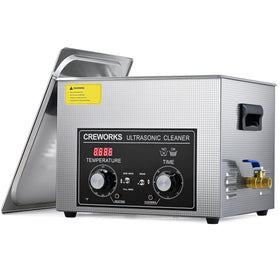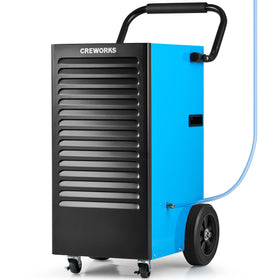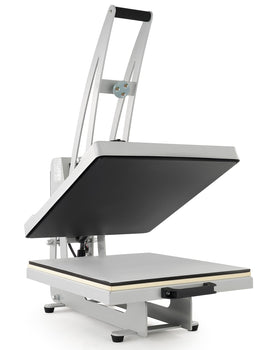With over 10000+ orders
With over 10000+ orders
Ultrasonic cleaners can be safe for most eyeglasses but may damage certain types depending on frame material, lens coatings, and construction. Metal frames and basic lenses typically handle ultrasonic cleaning well, but glasses with special coatings, plastic frames, or glued components face higher risk of damage.
This guide explains exactly when exactly these devices are safe to use and when they might damage your eyewear.

Not all eyeglasses respond the same way to ultrasonic cleaning. The safety largely depends on the materials and construction of your frames and lenses.
|
Frame Material |
Safe for Ultrasonic? |
Potential Risks |
|
Solid Metal (titanium, stainless steel) |
Yes - Generally safe |
Minimal risk with quality frames |
|
Metal Alloys |
Yes - With caution |
May weaken soldered joints over time |
|
Acetate Plastic |
No - High risk |
Can crack, warp, or lose polish |
|
Nylon/TR-90 |
No - High risk |
May become brittle over time |
|
Wood or Natural Materials |
No - Extreme risk |
Will absorb water and likely warp |
|
Horn/Shell Frames |
No - Extreme risk |
Can delaminate and destroy frame |
Metal frames typically withstand ultrasonic cleaning well, especially high-quality titanium or stainless steel frames.
According ultrasonic cleaning experts: Solid metal frames without soldered joints are least likely to experience damage from occasional ultrasonic cleaning. (Circuitnet)

However, ultrasonic cleaning can be very risky for eyeglasses with plastic frames.
The cavitation process can penetrate the material, potentially causing microscopic cracks that worsen over time. Acetate frames may also lose their polish or vibrant colors with repeated ultrasonic exposure. (Armoloy)
|
Lens Type |
Safe for Ultrasonic? |
Considerations |
|
Basic Glass Lenses |
Yes |
Most durable option |
|
Basic Polycarbonate |
Usually Yes |
Monitor for coating damage |
|
High-index Lenses |
Caution |
May affect anti-reflective coating |
|
Photochromic Lenses |
No |
Can damage light-sensitive layer |
|
Polarized Lenses |
No |
May damage polarization film |
|
Lenses with Multiple Coatings |
High Risk |
Coatings may separate or crack |
Anti-reflective coatings showed microscopic separation from lens surfaces after repeated ultrasonic cleaning, particularly at exposure times exceeding 3 minutes.
This means the thin anti-reflective layer that prevents glare can start peeling away from your lenses during ultrasonic cleaning, especially if you leave your glasses in the cleaner too long.
Certain eyeglass features are particularly vulnerable to ultrasonic cleaning:
Frames with glued components: The vibrations can break down adhesives, causing parts to separate
Decorative elements: Rhinestones, inlays, or other decorative features may become loose or fall out
Rimless or semi-rimless designs: The tension between lens and mounting points may change
Vintage glasses: Older frames often use materials or construction methods that don't withstand ultrasonic cleaning

If your glasses are compatible with ultrasonic cleaning, follow these guidelines to minimize potential damage:
Use the correct solution - Always use a solution specifically formulated for eyeglasses, never household cleaners or jewelry solutions
Keep cleaning cycles short - Limit cleaning to 1-2 minutes maximum
Use lower frequency settings - If your cleaner has adjustable frequency, use the lowest setting (around 20-25 kHz)
Remove before heating cycle - Some ultrasonic cleaners include a heating function; remove glasses before this phase
Support frames properly - Use a basket or holder to prevent frames from hitting the cleaner's sides
Test with inexpensive glasses first - If possible, test the process with an old pair before risking your primary glasses
Note: Even with these precautions, repeated ultrasonic cleaning may eventually cause damage to certain eyeglasses.
Further Reading: Here's a general guide on how to use an ultrasonic cleaner
The convenience of ultrasonic cleaning rarely outweighs the risk for premium eyewear, especially those with multiple coatings or complex construction.
Avoid ultrasonic cleaning entirely for:
High-end designer frames with plastic components
Glasses with specialty lens coatings (especially multiple coatings)
Frames with glued joints or components
Glasses with decorative elements attached to frames
Rimless or semi-rimless designs
Vintage or antique eyewear
Sunglasses with polarized lenses
Photochromic (transition) lenses
If your eyeglass types are not advised for ultrasonic cleaning. Here are the safe alternatives to keep your eyeglasses clean:
1. Manual cleaning with microfiber cloth
The safest method for all eyeglasses
Use a lens cleaning solution specifically designed for eyeglasses
Apply to a microfiber cloth (not directly to lenses)
Gently clean frames and lenses with circular motions
2. Lukewarm water and mild soap
Use fragrance-free, lotion-free dish soap (tiny amount)
Rinse thoroughly with lukewarm (never hot) water
Air dry or pat gently with clean microfiber cloth
3. Pre-moistened lens wipes
Convenient for on-the-go cleaning
Choose wipes specifically designed for eyeglasses
A microfiber cloth and lens-specific cleaning solution as the safest, most effective method for maintaining eyeglasses, regardless of frame or lens type.
Even for compatible glasses, limit ultrasonic cleaning to once every few months. Regular cleaning should rely on manual methods with appropriate eyeglass cleaners and microfiber cloths.
Yes, especially prescription lenses with multiple coatings. The risk increases with specialty prescriptions like progressive lenses or high-index materials that often require several coating layers.
Professional ultrasonic cleaners at optical shops are typically better calibrated and monitored by trained staff who understand which eyeglasses can safely be cleaned this way. However, they still pose risks to certain types of glasses.
No. Jewelry cleaning solutions often contain harsh chemicals that can damage lens coatings and frame materials. Always use solutions specifically formulated for eyeglasses.
Cloudiness typically indicates damage to lens coatings. The ultrasonic vibrations may have caused microscopic separations in the coating layers. Unfortunately, this damage is usually permanent.

Will damage your particular eyeglasses or not comes down to knowing your frames and lenses. While ultrasonic cleaners offer convenient cleaning for certain types of eyewear, they're not universal solutions.
Once again, for eyeglasses with plastic components, special coatings, or decorative elements—traditional cleaning methods are the safest choice.
When in doubt, consult your optician about your specific eyeglasses. They can provide guidance based on the exact materials and construction of your frames and lenses, helping you maintain your eyewear safely for years to come.












Leave a comment